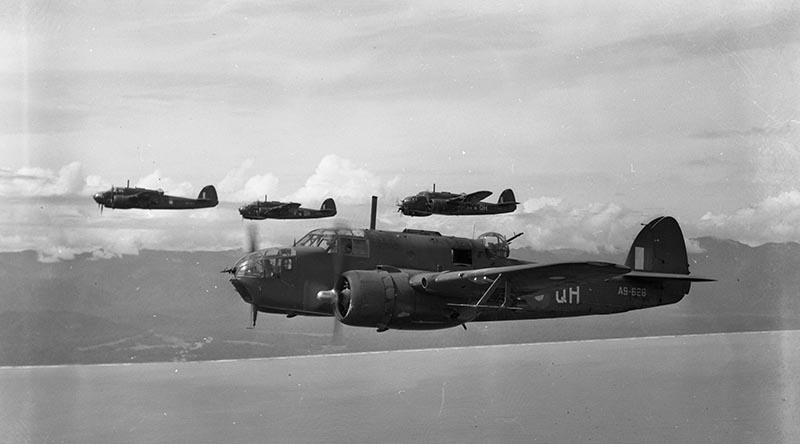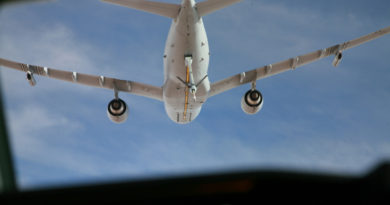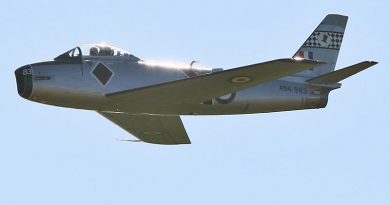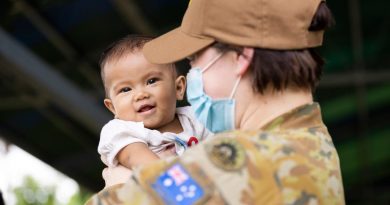Missing WWII bomber found off PNG

Royal Australian Air Force officials have positively identified a missing World War II aircraft, discovered late last year in waters off the coast of Gasmata, Papua New Guinea by Andrew Forrest and Ocean Ecology.
FILE PHOTO: Beaufort bombers in 1945. ADF photo.
RAAF No. 100 Squadron Beaufort bomber A9-374 was first reported missing in 1943 when it failed to return from a wartime mission.
Its discovery is the second made by Dr Forrest and the Ocean Ecology team in their ongoing search for Dr Forrest’s uncle, Flying Officer David Forrest, who was lost near Gasmata while piloting a similar RAAF Beaufort.
Chief of Air Force Air Marshal Stephen Chappell confirmed the identification of the crashed aircraft, made during a follow-up diving expedition earlier this year.
“The wreckage of A9-374 is dispersed over a large area in approximately 16 metres of water, which meant positively identifying the remains of the aircraft after 80 years took considerable time, effort and teamwork,” Air Marshal Chappell said.
“The mission involved the use of specialist divers and maritime archaeologists who worked on a complex site, featuring heavily damaged wreckage that was covered in layers of sediment and marine growth.
“I offer my heartfelt thanks to all involved in this significant mission.
“It is especially comforting for the families of the four aviators lost with their aircraft to know at last what happened to their loved ones, and to learn their final resting place.”
Beaufort A9-374 crew:
- Flight Lieutenant Roy Herbert Woollacott from 100SQN. Born in Burra, South Australia, he worked as a builder contractor before enlisting in Adelaide in June 1940. FLTLT Woollacott was 33 years old when he was killed in action.
- Flight Sergeant William Theodore Pedler from No 2 Air Ambulance Unit (on loan to 100SQN). Born in Blyth, South Australia, he worked as a farmer and grazier before enlisting in Adelaide in July 1941. FSGT Pedler was 21 years old when he was killed in action.
- Flight Sergeant James Albert Sugg from 100SQN. Born in Wagin, Western Australia, he worked as a school teacher before enlisting in Adelaide in March 1941. Flight Sergeant Sugg was 24 years old when he was killed in action.
- Flight Sergeant Harley Joseph Williams from 100SQN. Born in Launceston, Tasmania, he worked as a spare parts salesman before enlisting in Hobart in October 1941. Flight Sergeant Williams was 20 years old when he was killed in action.
A commemorative service for the families of all four crew is planned for October 2024 at RAAF Base Point Cook, Victoria.
Air Marshal Chappell said no further recovery was planned for the challenging crash site, but the Royal Australian Air Force continued to strive to account for all missing service personnel as part of its commitment to honouring their service and sacrifice for our nation.
“The Royal Australian Air Force acknowledges and thanks Dr Forrest and his team for their ongoing commitment to locate Dr Forrest’s uncle and his fellow missing aviators, and in helping to bring closure to another four families.
“The Royal Australian Air Force also acknowledges and thanks the government and people of Papua New Guinea, and especially the PNG National Museum and Art Gallery for their ongoing support.”
The location and identification of A9-374 is the second in the Gasmata area, following the location and identification of Beaufort A9-186 in 2022.
The remains of two aviators recovered during that investigation were farewelled by their families during a memorial service held at RAAF Amberley in April 2024, ahead of their repatriation for burial at the Bita Paka War Cemetery near Rabaul in November this year.
.
.

.
.





